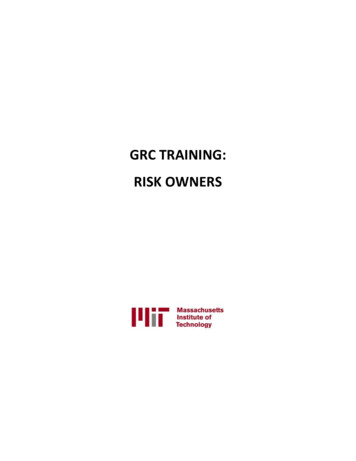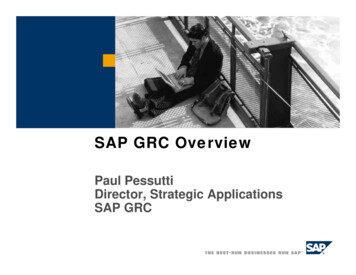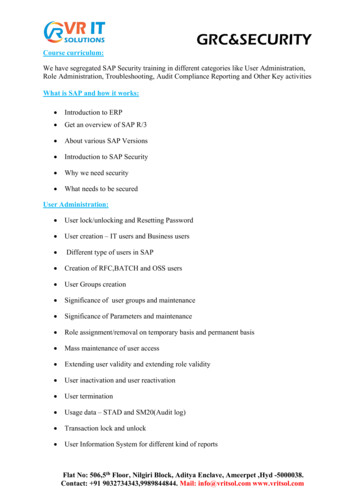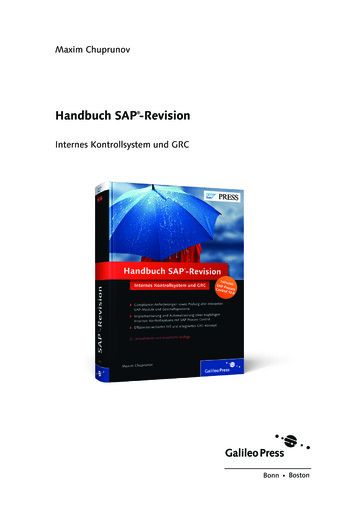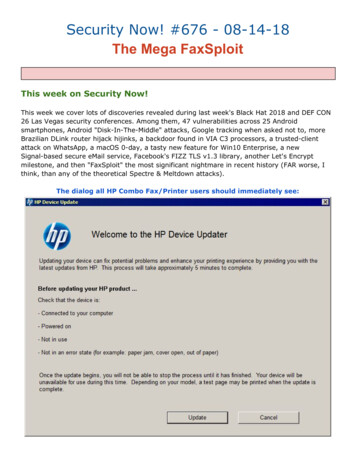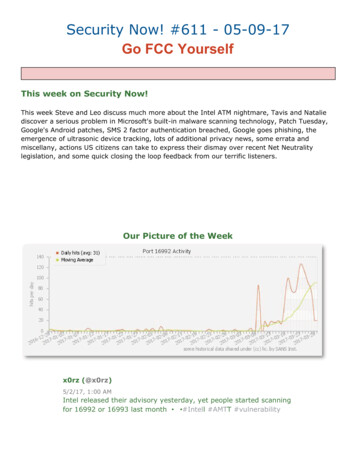
Transcription
Security Now! #611 - 05-09-17Go FCC YourselfThis week on Security Now!This week Steve and Leo discuss much more about the Intel ATM nightmare, Tavis and Nataliediscover a serious problem in Microsoft's built-in malware scanning technology, Patch Tuesday,Google's Android patches, SMS 2 factor authentication breached, Google goes phishing, theemergence of ultrasonic device tracking, lots of additional privacy news, some errata andmiscellany, actions US citizens can take to express their dismay over recent Net Neutralitylegislation, and some quick closing the loop feedback from our terrific listeners.Our Picture of the Weekx0rz ( @x0rz )5/2/17, 1:00 AMIntel released their advisory yesterday, yet people started scanningfor 16992 or 16993 last month #Intel l #AMT T #vulnerability
Security NewsIntel ATM follow-up.Last Monday, May Day, Intel released news of patches to critical vulnerabilities throughout therange of their vPro-based systems incorporating IME (Intel Management Engine) and Intel'sAMT.The AMT problem got a lot worse later in the week when the discovery was made public that alladmin authentication could be trivially bypassed.The guys at Tenable wrote this:On May 1, 2017 Intel disclosed the AMT vulnerability (INTEL-SA-00075), but details of thatvulnerability were not made public. However, Tenable researchers were able to overcome thischallenge and make Tenable the first to deliver Intel AMT vulnerability detection capabilities tocustomers, just minutes after Intel’s announcement yesterday. This is the story of how we did it.The huntThe first thing our research team tried was to set up a known vulnerable target. After somesearching, we found a Dell computer that had Intel AMT support but there was a problem. It wasnot configured/provisioned for what we needed.The Intel Management Engine Interface (MEI) driver was installed but the Local ManagementService (LMS) was not. Intel AMT documentation says the AMT configuration tool ACUWizard.exerequires LMS to be running.So we searched and found a software package for installing LMS on Dell's website. After LMSwas installed, we were able to configure/provision AMT on the computer, giving us access toAMT via the web interface.So. in other words, AMT could not be accessed by Intel's tool from within Windows without theinterfacing LMS service present and running.The Intel Management Engine / AMT ports: 16992: Intel AMT HTTPUsed for WS-Management (Web Services Management) messages to and from Intel AMT.This port is open over the network only when Intel AMT is configured or during theconfiguration process. Starting with Release 6.0, the port is optionally open when TLS isenabled. The port is always open locally. (But may NOT be open to the Network.) 16993: Intel AMT HTTPSUsed for WS-Management messages to and from Intel AMT when TLS is enabled. 16994: Intel AMT Redirection/TCPUsed for redirection traffic (SOL, Storage Redirection, and KVM using Intel AMT
authentication). Enabling the redirection listener enables this port.16995: Intel AMT Redirection/TLSUsed for redirection traffic (SOL, Storage Redirection, and KVM using Intel AMTauthentication) when TLS is enabled. Enabling the redirection listener enables this port. 623: ASF Remote Management and Control Protocol (ASF-RMCP)Used for RMCP pings. This port is a standard DMTF port and accepts WS-Managementtraffic. It is always enabled. 664: DMTF out-of-band secure web services management protocol ASF Secure RemoteManagement and Control Protocol (ASF-RMCP)Used for secure RMCP pings. This port is a standard DMTF port and accepts secureWS-Management traffic. It is always enabled. 5900: VNC (Virtual Network Computing) - remote control programUsed for KVM viewers that do not use Intel AMT authentication but use the standard VNCport instead. See Working with Port 5900 and Changing the Default KVM Port Setting.The guys at SSH.COM: "This is like giving everyone with intranet access root privileges on everyserver whose AMT port they can communicate with (including janitors who can plug into theinternal network). This also means root access to every virtual machine, container, and databaserunning on those servers. (People with internal firewalls and dedicated management networksare in a better position!)If your Active Directory server's AMT ports can be accessed, this is like giving every internal userDomain Administrator rights to your domains.Intel's INTEL-SA-00075 Detection -SA-00075 1.0.1.6.zipDisabling Intel AMT on Windows (and a simpler CVE-2017-5689 Mitigation -amtLinks: https://software.intel.com/sites/manageability/AMT Implementation and Reference Guide/default.htm https://software.intel.com/sites/manageability/AMT Implementation and Reference Guide/default.htm?turl MT Authentication Bypass - "Silent Bob is Silent"CVE-2017-5689, first discovered in mid-February by Berkeley, California researchers at "Embedi"who specialize in embedded system security. They reverse-engineered and examined Intel'sAMT code.As ArsTechnica wrote:
The hijacking flaw that lurked in Intel chips is worse than anyone thought"A remote hijacking flaw that lurked in Intel chips for seven years was more severe than manypeople imagined, because it allowed hackers to remotely gain administrative control over hugefleets of computers without entering a password. This is according to technical analysespublished worse-than-anyone-thought/While studying the Intel AMT Implementation and Reference Guide, the researchers learned thatvarious AMT features are available through the AMT Web-panel, which is supported by theintegrated Web server, which listens to ports 16992 and 16993.To protect the AMT from unauthorized access, the Web server provides several methodsof authentication and authorization of a remote user. Intel AMT supports both Digest andKerberos authentication though the Admin account always uses digest authentication.They wrote: "An admin account which is present by default, and always uses digestauthentication, seemed like an interesting thing to dig deeper into.Digest Authentication:A simple HTTP Challenge/Response authentication which allows the querying client to prove itshares a secret with the server.The client first issues an unauthenticated query which is rejected by the server with a "401Unauthorized" response. (We're all familiar with the "404 Not Found" response.)But the 401 Unauthorized response includes "realm", "nonce" and other protocol-negotiatingvalues which allow the client to then calculate a valid Authenticated query the second time.The client reissues the original query, this time returning the "realm", "nonce" values plus a"response" value which was cryptographically determined from the server-supplied data.MD5 generates a 128-bit hash, which is exactly and always 32 hex digits.Hash One MD5(username:realm:password)Hash Two MD5(method:digestURI)Client's Response MD5(HA1:nonce:HA2)So where's the bug?To verify the client's reply, the server internally computes the correct response it's expecting toreceive and compares that to the string it actually DID receive from the client.A comparison of two strings is essentially a comparison of two regions of memory over somenumber of bytes, where the regions are compared byte-by-byte looking to see whether theydiffer before reaching the end of the strings.The most obvious thing for any code to do, which wants to verify an MD5 hash, would be to
verify that the client provided exactly 32 hex characters, or 128-bits. If not, there's a clearprotocol error and authentication should fail.But failing that, properly written code that wishes to compare two strings for equality should atleast compare the lengths of the two strings to verify that their lengths are identical, sincediffering lengths would be an immediate disqualifier for string equality.But Intel's code doesn't do that. But it's even worse than that. If you're not going to comparethe two string lengths, then you at least want to compare the strings through the correct andexpected length (of 32 hex characters) which was calculated by the server. But Intel's codedoesn't do that either.Incredibly, the researchers discovered that Intel's AMT code was using the length of theCLIENT's provided string for the comparison! And if that length was ZERO, no comparison wouldever be performed, and the strings would be considered to be identical.What could an attacker could do after gaining an access to the AMT services?Intel AMT provides the ability to remotely control the computer system even if it’s powered offwhile electrically connected to power and the network.Also, Intel AMT is completely independent of OS installed on the computer system. Thistechnology allows OSes to be remotely deleted or reinstalled and there are a number of possibleattacks:KVM (remote control of mouse keyboard and monitor) can be used to remotelyperform any common physical actions (with mouse, keyboard) that would be done physically atthe computer. So any program could be remotely loaded and executed and any files read orwritten.IDE-R (IDE Redirection) allows the boot device to be remotely changed to another device or to avirtual drive image sourced locally or remotely.SOL (Serial over LAN) allows remote control of power, reboot, reset and more. The BIOSsettings can also be accessed and modified.Remember: Intel's security advisory of last Monday, May 1, 2017 referred to this as a "privilegeescalation" vulnerability in AMT.GRC's "ID Serve" utility:26 Kbytes, 14 years ago (2003). Downloaded about a million times.localhost:16992 & papers/Silent-Bob-is-Silent.pdfNatalie Silvanovich and Tavis Ormandy of Google Project ZeroTavis: MsMpEng: Remotely Exploitable Type Confusion in Windows 8, 8.1, 10, Windows Server,
SCEP, Microsoft Security Essentials, and es/detail?id 1252&desc 5Tavis Writes:MsMpEng is the Malware Protection service that is enabled by default on Windows 8, 8.1, 10,Windows Server 2012, and so on. Additionally, Microsoft Security Essentials, System CentreEndpoint Protection and various other Microsoft security products share the same core engine.MsMpEng runs as NT AUTHORITY\SYSTEM without sandboxing, and is remotely accessiblewithout authentication via various Windows services, including Exchange, IIS, and so on.On workstations, attackers can access mpengine by sending emails to users (reading the emailor opening attachments is not necessary), visiting links in a web browser, instant messaging andso on. This level of accessibility is possible because MsMpEng uses a filesystem minifilter tointercept and inspect all system filesystem activity, so writing controlled contents to anywhereon disk (e.g. caches, temporary internet files, downloads (even unconfirmed downloads),attachments, etc) is enough to access functionality in mpengine. MIME types and file extensionsare not relevant to this vulnerability, as MsMpEng uses it's own content identification system.Vulnerabilities in MsMpEng are among the most severe possible in Windows, due to the privilege,accessibility, and ubiquity of the service.The core component of MsMpEng responsible for scanning and analysis is called mpengine.Mpengine is a vast and complex attack surface, comprising of handlers for dozens of esotericarchive formats, executable packers and cryptors, full system emulators and interpreters forvarious architectures and languages, and so on. All of this code is accessible to remoteattackers.NScript is the component of mpengine that evaluates any filesystem or network activity thatlooks like JavaScript. To be clear, this is an unsandboxed and highly privileged JavaScriptinterpreter that is used to evaluate untrusted code, by default on all modern Windows systems.This is as surprising as it sounds.We have written a tool to access NScript via a command shell for testing, allowing us to exploreand evaluate it.Before executing JavaScript, mpengine uses a number of heuristics to decide if evaluation isnecessary. One such heuristic estimates file entropy before deciding whether to evaluate anyjavascript, but we've found that appending some complex comments is enough to trigger this.The attached proof of concept demonstrates this, but please be aware that downloading it willimmediately crash MsMpEng in it's default configuration and possibly destabilize your system.Extra care should be taken sharing this report with other Windows users via Exchange, or webservices based on IIS, and so on.As mpengine will unpack arbitrarily deeply nested archives and supports many obscure andesoteric archive formats (such as Amiga ZOO and MagicISO UIF), there is no practical way toidentify an exploit at the network level, and administrators should patch as soon as is practically
possible.We have verified that on Windows 10, adding a blanket exception for C:\ is enough to preventautomatic scanning of filesystem activity (you can still initiate manual scans, but it seemsprudent to do so on trusted files only, making the action pointless).Microsoft Security Advisory 4022344Security Update for Microsoft Malware Protection security/4022344#ID0E3AACFor affected software, verify that the Microsoft Malware Protection Engine version is 1.1.13704.0or later.To check your MsMpEng version:Open Microsoft Security Essentials.Drop down the Help menu at the upper right.Choose "About"See: Engine Version: (Mine was 1.1.13701.0)After today's Patch Tuesday: 1.1.13704.0)Microsoft Patch TuesdayPatching more than 20 vulnerabilities for every platform, of which 4 are rated CRITICAL.Go
MsMpEng is the Malware Protection service that is enabled by default on Windows 8, 8.1, 10, Windows Server 2012, and so on. Additionally, Microsoft Security Essentials, System Centre Endpoint Protection and various other Microsoft security products share the same core engine.





